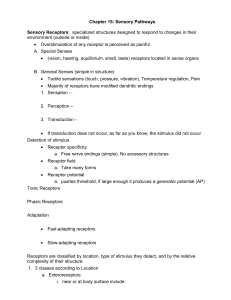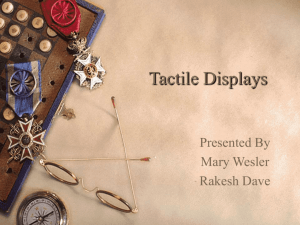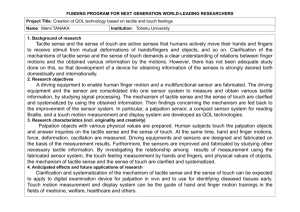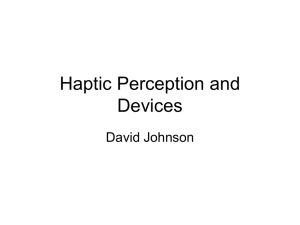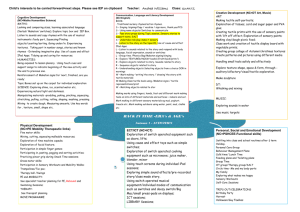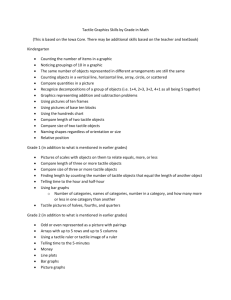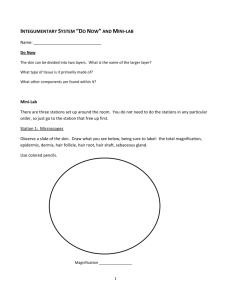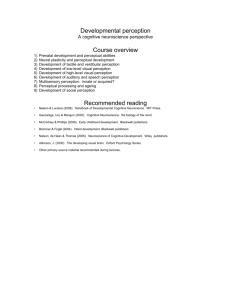2 related research
advertisement
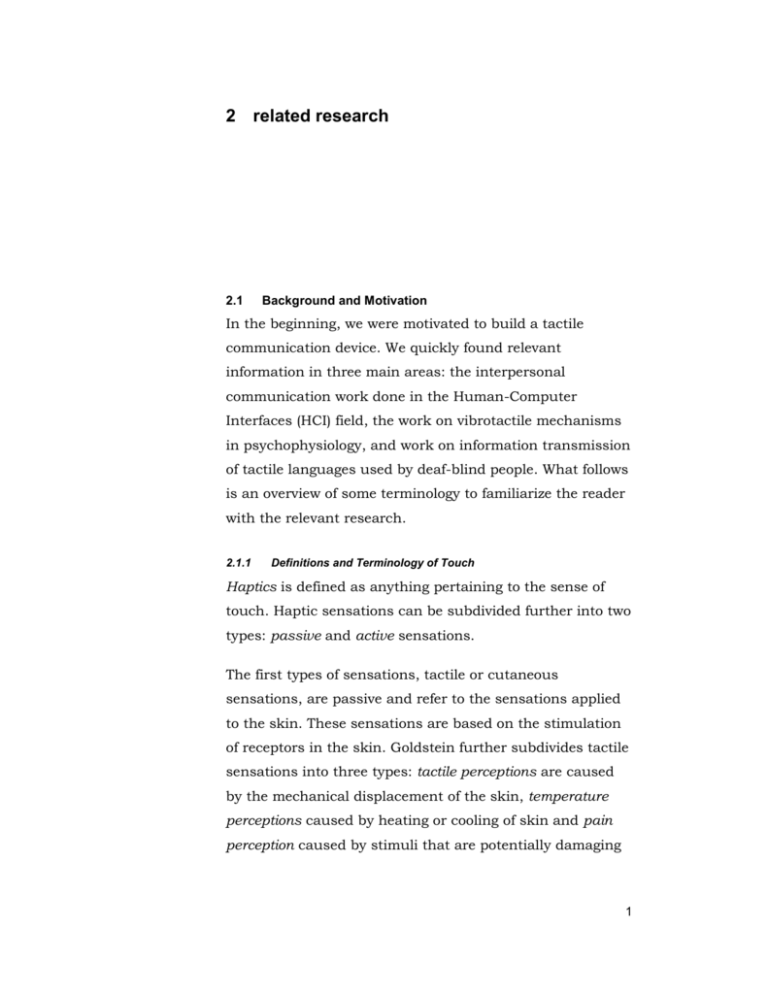
2 related research 2.1 Background and Motivation In the beginning, we were motivated to build a tactile communication device. We quickly found relevant information in three main areas: the interpersonal communication work done in the Human-Computer Interfaces (HCI) field, the work on vibrotactile mechanisms in psychophysiology, and work on information transmission of tactile languages used by deaf-blind people. What follows is an overview of some terminology to familiarize the reader with the relevant research. 2.1.1 Definitions and Terminology of Touch Haptics is defined as anything pertaining to the sense of touch. Haptic sensations can be subdivided further into two types: passive and active sensations. The first types of sensations, tactile or cutaneous sensations, are passive and refer to the sensations applied to the skin. These sensations are based on the stimulation of receptors in the skin. Goldstein further subdivides tactile sensations into three types: tactile perceptions are caused by the mechanical displacement of the skin, temperature perceptions caused by heating or cooling of skin and pain perception caused by stimuli that are potentially damaging 1 to skin. The research here is primarily concerned with the use of these tactile sensations. The active types of sensation are proprioceptive and kinesthetic sensations. Proprioceptive sensation refers to the awareness of position of your limbs. Kinesthetic sensation refers to the sense of movement of the limbs. From these sensations, the skin provides useful information to the brain. The combination of sensations that results in communication of information is of particular interest. In order to realize the possibilities of how to present information via our tactile senses, it is useful to know about the mechanics of touch. Figure 2-1. Cross section of the layers of hairless skin showing some of the receptors. The four main receptors of touch are circled. (Adapted from Sensation and Perception Goldstein p.438) 2.1.2 A Brief Overview of the Mechanics of Touch The composition of skin determines the sense of touch using the three different types of sensation described earlier. These sensations allow the skin to act in two main capacities: to separate our insides from the environment and also to provide us with information about the environment. Some of the functions of skin are to warn of danger, prevent body fluids from escaping, protect our internal organs from external irritants, exert pressure on objects, and sense temperature. As depicted in Figure 2.1, the skin consists of many layers. The outermost layer is called the epidermis, composed of several layers of dead skin cells. Under the epidermis is the dermis, an inner layer containing nerve endings. The skin contains a vast amount of receptors throughout the epidermis and dermis. 2 Figure 2.2 depicts the four major receptors for tactile perception in order of closeness to the epidermis: Merkel receptor, Meissner corpuscle, Ruffini cylinder and Pacinian corpuscle. These receptors are designed to perceive different cutaneous perceptions such as pressure, flutter, buzzing, and vibration. Unlike our eyes and ears, the haptic stimuli receptors are not encapsulated in a single organ, but rather distributed along the body. A higher concentration of receptors in certain parts of the body such as hands and lips results in greater sensitivity to tactile sensations in these areas. Figure 2.3 shows the sensory homunculus diagram Figure 2-2. Cell receptors The four major receptors for tactile reception and their frequency range of response (Adapted from Goldstein pp.438-439. representing the brain’s processing of the distribution of touch. Notice that the area of the hand occupies the largest Receptors Frequency range Perception a) Merkel receptors 0.3-3Hz (slow pushing) Pressure b) Meissner corpuscle 3-40 Hz Flutter 3 cortical area. This unequal distribution shows that the brain dedicates a large area of receptors for the fingers. Compared to other body parts, our hands have a high density of tactile receptors. This makes the hand an ideal site for receiving information (Reed 1991). 2.1.3 Psychological Aspects of Touch to feel around us (perception) and get these signals to our brain in order to decide where to move (cognition). Klatzky and Lederman proved that the haptic system is very efficient at recognizing 3D objects. In their 1987 study, users optimized their tactile senses using a large number of exploratory procedures (EPs) for taking in information and manipulating objects. Some EPs are: enclosing objects with Figure 2-3.The sensory homunculus diagram representing the brain’s processing of the distribution of touch. Survival, perception, cognition are functions of touch in everyday life. In order to survive, we need to move. the hands, following contours, applying pressure, and using lateral motion. The researchers found that people tended to use the same types of EPs depending on the desired information needed about the object. Touch does more than just give us information about our surroundings, it also helps us express emotions (e.g. patting, squeezing, stroking). Touch has high emotional value. Ackerman (p.71) writes, “We call our emotions feelings, and we care most deeply when something ‘touches’ us.” The intensity of emotion has correlations with the intensity of physical expression. The skin is the site at which the body releases endorphins for pain and excitement. Social and behavioral scientists have long used the skin conductivity as an indicator of emotion (Dawson 1990). 4 2.1.4 Cognitive aspects of touch in combination with other modalities Our senses often act in unison to present a cohesive story to our mind. Crossmodal interactions are when a combination of the senses of touch, taste, smell, hearing, vision jointly act. When crossmodal interactions occur to verify one another, cognition happens more robustly than when only one sense is acting alone. When the senses disagree, we often experience what are called “sensory illusions”, because the mind has difficulty resolving the meaning of the stimuli. One such illusion is “visual capture”, which often occurs in movies where a character’s voice is perceived as coming from their mouth even though it is really coming out of a loud speaker somewhere else. Our reliance on different senses can vary depending on the situation. For example, as one ages, the sense of hearing and sight tend to degrade. On the contrary, in the dark our hearing and sense of touch are heightened. In this research, we are particularly interested in the effect of the combination of senses. People naturally use a combination of modalities in order to understand their environment. These combinations affect perception in different ways. Three types of sensory interactions are widely studied because of their powerful effects on human perception and cognition: sensory substitution, sensory redundancy, and synesthesia. Sensory substitution is the process of substituting information from one sensory modality for another in order to perceive an object. One example of sensory substitution is when people who are deaf rely on the lip reading, a visual sense. 5 Sensory redundancy or sensory augmentation is the process of adding information from one modality to help another. When the senses act together to verify each other, perception occurs much strongly. An example of sensory redundancy is when you see a rose, but you have to smell and touch it to verify whether it is real. Although a rare condition, synesthesia is when stimulation of one modality triggers stimulation of a different modality. For example, a person might associate seeing different colors when hearing certain sounds. Usually, this results in a very compelling experience for the person. 2.1.5 Tactile illusions Brown and Stevens give an overview of two ways of stimulating the skin using artificial stimulae. Vibrotactile means to use vibration signals delivered by one or more vibrators on the skin. Electrotactile means to use electrical stimulation (e.g. by means of surface electrodes) to deliver signals to the skin. It is interesting to note that certain tactile stimulation can cause illusions on the skin. One interesting phenomenon we hope to exploit is the cutaneous rabbit, also known as sensory saltation (Geldard 1972). When given a number of distinct vibrational pulses along the forearm, people felt the vibrations were moving up their arm linearly. In effect, their mind was interpolating the effect of phantom vibrators. The components necessary for this effect to occur are actuators at the desired endpoints of the linear gesture, and the correct relationships in timing and amplitude between the pulses used to generate the illusion. The saltation effect has analogies in vision and audition, where the person perceives more stimuli than are 6 actually available (Tan 2000). In Tan’s study, people who were naïve to vibrotactile stimuli could readily distinguish patterns of movement without any training. There are two significant implications of sensory saltation. One implication is that there is no learning curve for experiencing this phenomenon. The results also imply that not as many actuators are needed to achieve the perception of movement across the skin. This research provokes the notion that gestures are possible with only a few actuators. One idea is that gestural movements can be possible by starting a motion in one direction that can be completed mentally by the user. 2.2 Relevant Research The following sections contain descriptions of relevant research in three main areas: Research on interpersonal communication in HCI provides insight on how the sense of touch is conveyed remotely. Research in the field of psychophysiology investigates how tactile stimuli can be used for communication. Work on sensory communications describes touch as used by sensory impaired people, and their use of tactile languages. 2.2.1 Haptic Interpersonal Communication ComTouch was primarily influenced by prior work in the field of haptic interpersonal communication. This work demonstrated that technology was capable of connecting people using touch in real time. Many previous attempts to communicate touch in real time employed the use of mechanical linkages. In the early 80s, Telephonic Arm Wrestling introduced the idea of haptic remote 7 communication using simulation over a telephone line that controlled levers (White 1986). 2.2.1.1 Social communication Later research focused on the interactions afforded by these devices. Fogg’s HandJive used linked hand-held joysticks for haptic entertainment (Fogg 1998) and found that tactile interaction was socially enjoyable. Brave’s research on computer-mediated communication provided additional evidence that the context of the device usage can either foster cooperation or competition (Brave 2001). Due to the broadcast nature of audio and video, many existing communication devices compete for our attention. The senses can become overloaded and important information may be overlooked. The personal communication devices of others often needlessly interrupt our attention and compromise our privacy. One solution is to employ the underused modality of touch. Researchers at FXPal have focused on integrating media and modalities with research on calm technology (Nelson 2002), in hopes to soften the impact of interruption caused by current communication devices. 2.2.1.2 Emotional connectivity Several artistic explorations advanced the idea of haptic interpersonal communication by using digitally augmented objects to transmit presence information remotely, such as Dunne and Raby’s presentation at Doors of Perception (Dunne 1994). Exploratory combinations of various interface modalities and input-output mappings evoke awareness of a remotely located person. Feather, Scent, Shaker demonstrated how touch could be mapped to scents, light and vibration (Strong 1996). Ishii’s InTouch 8 recreated a symmetric mapping of touch over distance by preservation of the physical analog movement of rollers (Ishii 1997, Brave 1997a) and described the notion of tangible telepresence, using touch to connect remotely located people through different mediums [Ishii. In his thesis on personal ambient displays Wisneski explores displaying telepresence information through tactile modalities using “thermal change (heating and cooling), movement (shifting and vibration), and change of shape (expanding, contracting, and deformation) (Wisneski 1999a).” Wisneski further discusses the reasons for utilizing tactile displays to keep information private, and reducing interference with other visual and auditory activities. Wisneski’s vision of ambient devices to transmit information in the background of a person's perception expanded on the use of ambient displays using expressive kinetic objects by Dahley (1998a, 1998b). Following Ishii’s exploration of ambient media to demonstrate information flow (Ishii 1998), physical objects were also used by Tollmar et al. to explore telepresence in home environments. Tollmar represents the interaction of remotely located people with everyday objects such as stones, chairs and portraits (Tollmar 2000). Further explorations introduced artifacts for emotional communication, such as the Kiss Communicator by IDEO used the active motion of a kiss to display colorful lights on remote objects (Buchenau 2000). LumiTouch is a digitally augmented picture frame that explored the passive communication of presence (Chang 2000). Grimmer’s Heart2Heart vest allowed a touch to convey heat, pressure, 9 and heartbeat wirelessly to mimic a physical embrace (Grimmer 2001). 2.2.2 Vibrotactile research The design and implementation of ComTouch relies mainly on the existing body of vibrotactile (touch and vibration) research. Geldard first introduced the notion of applying vibrotactile stimuli to the skin, and showed that people could learn an invented tactile body language called vibratese (Geldard 1967). Tan, Reed and Durlach proved that the hand-based reception language of Tadoma could transmit very accurate information (Tan 1997). Tan further investigated the use of vibrotactile interfaces to engage the full hand (Tan 1994, 2000). Her Tactuator, a three-fingered sensory substitution device, used a tactile interface for improving the reception of speech (Tan 1996). Gunther’s SkinScape used vibration devices distributed throughout the body to enhance the audio experience by immersing audience members in musically synchronized tactile compositions (Gunther 2001). 2.2.3 Tactile languages The available tactile languages provide insight into the vast amounts of information that can be achieved by use of skin. Deaf-blind people can use a variety of tactile communication languages. Fingerspelling is a tactile language where the pressure and expressive movements of one hand is received on another hand. Tadoma is a method where the receiver places his thumbs on the lips of the speaker, with fingers on the throat. Tadoma can be so precise as to allow the user to detect intonation information from the vibrotactile stimuli (Tan 1996). In comparison, Braille is a static alphabetic representation coded using 10 raised dots. “Braille can be read at 100 words per minute, slower than the rate for visual reading, which averages about 250 to 300 words a minute” (Goldstein 2002, p. 406) Because Braille consists of discrete patterns, it can be computerized, and thus provide remote communication possibilities. However, the transmission and reception of Braille is much slower than Tadoma. Morse code, when transmitted in the form of tactile signals, is also a form of touch communication. Advanced users were able to efficiently use shorthand and perform simultaneous speech encoding and decoding of Morse messages (Tan 1996). These findings indicate that a touch-based communication language can be a very versatile communication tool. A brief review of tactile communication languages demonstrates the potential use of touch as a primary communication medium. Deaf-blind people can use a variety of tactile communication languages. In an overview of existing methods, Reed mentions four common traits of natural tactile communication that may be relevant in the higher rates of successful information transfer (Reed 1991): The use of the hand as the site for reception of tactual simulation, the activation of both the cutaneous and the proprioceptive branches of the tactual sensory system, the simultaneous presentation of information along a number of different dimensions, and the extensive training periods of use for a particular method. 11 2.2.4 2.2.4.1 Review of Commercial Products Force Feedback Devices Assessment of the commercial products allowed us to develop an idea of technological advances and market needs. We noted the use of force feedback and vibration in entertainment devices (like Aura System’s Interactor Vest, Immersion’s Impulse Engine 2000 Joystick, BSG System’s Intensor chair, VRF’s Tactile Feedback System, and SensAble’s PHANToM) to provide more physical interaction with computer games, enhancing the gaming experience. 2.2.4.2 Vibrotactile Perception Commercially available vibration devices, such as Logitech’s iFeel mouse, serve as a redundant sensory display for visual information by enabling users to physically feel onscreen boundaries. Vibrating pagers and mobile phones can subtly get a user’s attention during an important meeting. Many tactile aids for the deaf translate audio signals into vibration. Multimodal communication devices, such as the Tactaid device (Verillo 1992), are often used when the information transmitted using a particular single modality could be lost due to the environment or the abilities of the individual. The Optacon (Goldstein 2002, p.209) is a device that translates printed words or pictures into patterns of vibrating pins. 2.2.4.3 Hand-based Input Devices An investigation into ways in which the hand inputs information into the computer led to a wide array of keyboard devices. Doug Engelbart’s 5-finger keyboard spawned many similar types of chording keyboard devices using just one hand. One popular input device used in wearable computing is HandyKey’s Twiddler, a mobile, 12 compact and wireless chording keyboard that allows for single-handed mouse and alphanumeric input. There are even a number of keyboards that strap to the wrist. The existence of these devices arises mainly from a need to use the hand more efficiently (i.e. in virtual reality situations, and mobile computing). The devices are geared to maximize the use of the hand as an input method. Also, most of these devices require some time to learn before the user is proficient. This implies that any new input device will have some learning curve. 13 11
